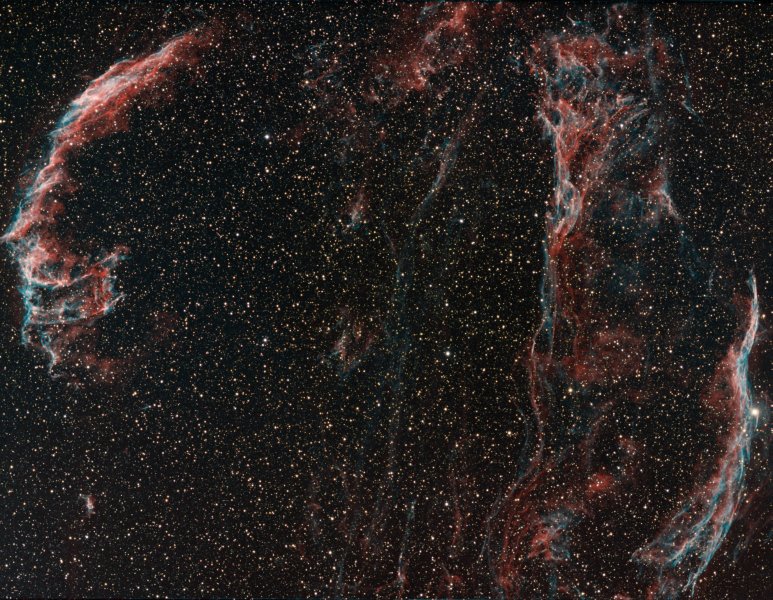The Veil Nebula Complex
|
 |
Around 10,000 years ago a brilliant star lit up
the night sky in the vicinity of the constellation Cygnus the
Swan and shone brilliantly for a few weeks. While there are no
known records of this event, it is quite likely that quite a few
early humans were awed and dazzled by the appearance of this
“guest” star. We now know that that this “new star” was a
supernova, or a massive star that blew itself apart at the end
of its tumultuous life. Telescopes aimed at this point in space
now reveal the aftereffects of the explosion, still evident
after all this time.
The Veil Nebula shows up as discrete tendrils of gas covering
about 3 degrees of sky (6 times the diameter of the Full Moon).
The components have been given different catalog entries, though
wide-field images like this reveal them to display a somewhat
circular shape, hinting at the expanding shock wave from the
blast. The tendrils of gas are not the remnants of the dead star
but the shock wave from the blast crashing into and interacting
with interstellar gas at speeds of over a million kilometers per
hour! This nebula is visible with small telescopes at dark
sites, and can be seen with proper filtration from
light-polluted skies. Views of this nebula from dark sites with
big telescopes and proper filtration are memorable.
This is a narrow-band/RGB emulation, mapping H-alpha data (7.5
hours total exposure) to Red, OIII (6.5 hours exposure) to green
and a blend of H-alpha and OIII (simulating H-beta) to blue. 70
minutes each of RGB data was also imaged to give the stars a
natural RGB color. The data for this image was taken over
several nights in July, 2008 from my backyard in West Chester,
Ohio. |
| |
|
Constellation: Cygnus |
|
When Visible: July - December |
|
Distance: 2,600 Light-years |
|
Date: July 2008 |
|
Location: West Chester, Ohio |
Exposure Details:
H-alpha: 15 x 30 minutes
OIII: 13 x 30 minutes
R: 7 x 10 minutes binned 1x1
G: 7 x 10 minutes binned 1x1
B: 7 x 10 minutes binned 1x1 |
| |
| Equipment used: Takahashi
FSQ-106N on an Astro-Physics AP1200GTO mount. SBIG STL-6303
camera with 8-position filter wheel and Astrodon filters.
Externally guided with an SBIG Remote Guide Head on a Borg 45ED
refractor. |
| |
| Acquisition Software: MaximDL,
TheSky6, CCDAutopilot |
| Processing Software: MaximDL,
Photoshop CS, IrFanView |
|
|
